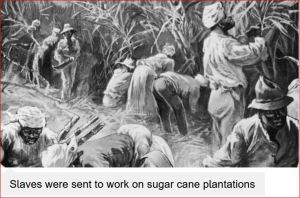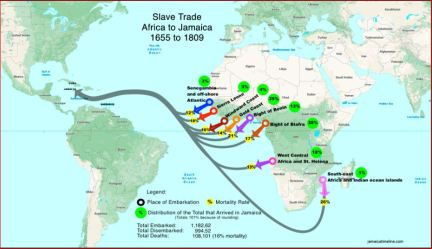.
UK dispatched about 10,000 voyages to Africa transporting 3.4 million or more enslaved Africans over 245 years.…Between 1750 and 1780, about 70% of the [UK] government’s total income came from taxes on goods from its colonies.…"The Caribbean Islands became the hub of the British Empire.”
“Britain and the Caribbean,” bbc.co.uk
 (p. 3) “Every slave was expected to work-even women, children and the elderly.
(p. 3) “Every slave was expected to work-even women, children and the elderly.
Life on the plantations was extremely hard with a third of newly imported slaves dying within three years. This created a constant demand for new slaves to replace them.”…
“The demand for slaves [in Jamaica] required about 10,000 to be imported annually...About 600,000 slaves disembarked in Jamaica between 1750 and 1808.”…
(p. 6) “West-Indian plantation owners…
(p. 2) “In 1700, Britain’s sugar consumption was 4 pounds (weight) per person, a century later that had risen to 18 pounds per person.
The increased availability and popularity of sugar was due to a gradual increase in the standard of living (whereas before only the very rich could afford such luxuries as sugar) and the discovery of more New World colonies which were ideally suited to the growing of luxury crops such as sugar….
The need for slaves
Sugar production was labour intensive. The increased demand led Europeans to forcibly transport Africans as slaves.
In 1746, economist Malachi Postlethwaite wrote, “If we have no Negroes, we can have no sugar, tobacco, rum etc. Consequently the public revenue, arising from the importation of plantation produce, will be wiped out. And hundreds of thousands of Britons making goods for the triangular trade will lose their jobs and go a begging”.
Many agreed with him, believing that the slave-based plantation system was vital to British wealth, industry and jobs…
(p. 7) Financial considerations
Slave labour…
Sugar growing was labour-intensive, requiring many slaves to make it profitable.
The rich planters could also afford to work enslaved people to death and then buy more.
Profits from slave labour
Between 1630 and 1807, Britain’s slave merchants made a profit of about £12 million on the purchase and sale of African people. Slaves produced about 75 per cent of exports of raw goods from the new colonies.
Banks and insurance
Sailing across the Atlantic was dangerous however and combined with the harsh conditions on the slave ships, there was a high risk of human and non-human cargo being lost ‘en route’. Britain’s oldest insurance company, Lloyds of London, underwrote (insured) slave ships. Barclays Bank also began by investing in the slave trade.”…image above from BBC
…………………………………
Added: Map: UK slave voyages from Africa to Jamaica, 1655-1809.
Source: Slave Voyages Database-Trans-Atlantic Slave Trade-Estimates, via JamaicaGreatHouses.com…
...........


No comments:
Post a Comment